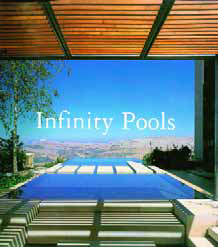vanishing edge
With water-in-transit effects becoming more and more popular, increasing numbers of watershapers find themselves in need of external tanks to give these systems the surge capacity they need to function at peak efficiency. Here, Paolo Benedetti discusses his preferences when it comes to setting up his surge tanks – and defines a number of issues designers and builders should consider in making them both reliable and serviceable. As a rule, the surge tanks used in
Sometimes watershaping is so much fun that it seems less like a job than a labor of love. That was absolutely the case with the watershape pictured here: I was given free rein to do exactly what I thought was needed in collaboration with great clients and a wonderful project team on a spectacular property. And as if that wasn’t good enough, we ran into virtually no problems along the way, even though we were working in a city sometimes known for setting obstacles in the way of ambitious designs. We at Pure Water Pools (Costa Mesa, Calif.) get involved in numerous custom projects every year, and the work just seems to get more creative, interesting and satisfying as we move along. I’m not willing to say we’ve peaked by any stretch of the imagination, but it feels good to think that this may well be
It’s not unusual for watershapers to have their signatures. For some, these noteworthy effects extend from their educations and personal design preferences, while for others, inspiration comes from distinctive qualities found in local landscapes or from tailoring designs to suit the characters of their clients. In our case, we at Hydroscapes (Fountain Hills, Ariz.) pull on all of the above and more in our design work. Through the years, we’ve done a lot of projects associated with Contemporary-style architecture – a specialty, perhaps, but not what we’d call a signature. This work has led us to invest lots of time in studying modern masters including Frank Lloyd Wright and John Lautner – and, as they did, in learning about Japanese garden design and the work of the great Craftsmen architects such as Greene & Greene. Those influences flow neatly together for us because all of those designers embrace simplicity of line and form as well as elegance in the use of colors and materials. It doesn’t hurt that these legacies suit our personal tastes as a husband-and-wife design team – and it helps even more that a majority of our clients these days seem to start with similar ideas in mind: They want
Last month, I did my usual annual roundup of books that feature custom residential swimming pools. I must confess that I deliberately withheld one such book from the usual summary treatment because it was just too good for me not to give it a full column's attention this time around. The book - Infinity Pools by Ana G. Canizares (Collins Design, 2006) - is one of the best on pools as a design genre that I've ever seen. In fact, one of the few things I don't like about it is the title, because I've always preferred the term "vanishing edge." That quibble aside, I think she's done a terrific job of presenting what has to be the most powerful, influential design look of the past 20 years. More important, she manages to do so without making these pools seem a visual cliché. As is demonstrated repeatedly
In December 2004, WaterShapes introduced ‘The Platinum Standard,’ a registry of projects that embodies watershaping…
In December 2004, WaterShapes introduced ‘The Platinum Standard,’ a registry of projects that embodies watershaping…
In December 2004, WaterShapes introduced ‘The Platinum Standard,’ a registry of projects that embodies watershaping…
With every new project, we always strive to create unique watershapes that reflect particular clients’ wants, needs, dreams and imaginations. What this means, given the fact that every client is an individual, is that no two of our pools are ever quite the same. In the case described in this article, for example, the clients’ distinctive personalities led us to create something that’s more like a waterpark than a residential pool/spa combination. In a very real sense, it reflects their personalities and a sense of the magic they find in certain chapters of our history – a special space for them to enjoy with their children. The clients purchased the newly built home on a hill overlooking the ocean in
When used to classify a design style, the term “modern” can carry many meanings. From the soaring, audacious forms of Frank Gehry and the sweeping organic spaces of John Lautner to the hard rectilinear shapes of Le Corbusier and the gem-like transparency of Mies van der Rohe, modernism is truly a broad conceptual umbrella. That sprawling diversity leaves designers and their clients with lots of wiggle room to get things done, but even so there can be challenges – as in the case depicted here, where the clients' desire for




















